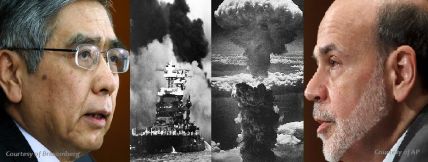|
|
Op-Ed
Pearl Harbor and Hiroshima bombings Turn into Covert Currency War
Sunday, August 11, 2013

By Anthony Rowley
Tokyo- (PanOrient News)
When the Bank of Japan launched its monetary bombshell on April 4, taking the rest of world by surprise and financial markets by storm, some termed it Japan's "second Pearl Harbor" after the surprise military strike by the Imperial Japanese Navy on the US naval base in Hawaii in 1941.
Now they are wondering whether the follow-up action not long afterwards by the US Federal Reserve in hinting at an end to quantitative monetary easing (QE) might have been a "nuclear" response by Washington to Japan's bold attack on deflation and the strong yen - a "second Hiroshima" so to speak.
If this sounds implausible or even preposterous, there is no doubt that "currency wars" are still being waged by the US and Japan - not to mention the euro zone countries - even if these battles have gone underground and are referred to only by the code name of "QE" nowadays.
This covert form of warfare allows one country to gain export advantage over another by flooding its financial system with liquidity, which usually leads to capital outflows and currency depreciation. But although the US fired the first shots and won the first battle, while Japan scored the second victory, no-one can hope to emerge victorious in the long run.
The skirmishes are accompanied by extreme turbulence in currency markets, which damages confidence and business investment, as we are seeing now. But the bigger problem is that once you get into QE-type offensive operations it is difficult or even impossible to withdraw without suffering serious collateral damage.
Let's look at recent history. In 2010, President Obama announced in his State of the Union address his aim of doubling US exports within five years. This was a very ambitious target and hitting it required the deployment of some unusual weapons, one of which was a weaker dollar.
The Fed duly launched a second round of Quantitative Easing or QE in November 2010, following on the heels of QE1 which had been launched at the time of the 2008-09 global financial crises to keep the global financial system liquefied and the US economy afloat.
QE, as any student of economics knows, is an unconventional monetary policy used by central banks to stimulate a nation's economy when standard monetary policy becomes ineffective. The central bank buys financial assets from commercial banks and other institutions to increase the monetary base.
Since QE usually has the effect of lowering domestic interest rates, this encourages outflows of capital in search of higher yields. This in turn depreciates the exchange rate of the QE-deploying nation, which is what happened in the US case. The Fed then launched QE3, continuing the cycle.
The Bank of England had its own QE exercises but as Britain is no longer a major exporter these did not upset the US. Neither did Mario Draghi's massive monetary easing at the European Central Bank (ECB) because the euro zone was in crisis and was focused on issues other than exports.
But then Shinzo Abe's government came to power at the end of last year, declaring that (a long-stagnant) "Japan is back" and at the same time demanding aggressive and US-rivaling monetary easing from the Bank of Japan. Kuroda was chosen as the man to "deliver" and he did not disappoint.
He outdid even the Fed with his April 4 blockbuster. Announcing what he called "a new phase of monetary easing, both in terms of quantity and quality", Kuroda promised to double Japan's monetary base within two years and thus surpassed the Fed in terms of the size and audacity of his moves.
These moves, he said, were aimed "purely at ending deflation and boosting domestic economic activity" in Japan but they sent the yen into a tailspin against the dollar and that caused hackles to rise in Congress (as well as in China) where they were seen as a deliberate yen-weakening ploy.
Japan learned hard lessons from the 1985 Plaza Accord about what happens when the yen is driven up by external action, producing deflation (delayed in Japan's case by the onset of the bubble economy) and economic stagnation. But then (28 years later) came Japan's chance to strike back.
Japan is a highly efficient exporting machine when not handicapped by an over-strong currency, as the rest of the world learned to its cost in the 1980s in the run-up to the Plaza Accord. After the Kuroda bombshell and the yen's plunge against the dollar, Japan appeared all set to roar back.
Hence the "Pearl Harbor" theory. The US appeared to be taken off guard at first. It could hardly scold Tokyo for doing what it had already done itself by launching mega monetary easing, and yet US business lobbies were demanding action against the "weak yen."
Japan has become a bigger export potential rival to the US now that it is not just a case of, say Ford or Chrysler competing against Toyota or Nissan in selling automobiles. Japan is now pushing exports of everything from nuclear plants to high-speed trains - and price competition matters.
The intriguing question now for conspiracy theorists is whether the US began putting about the notion of imminent monetary tightening in order to reverse the new Pearl Harbour assault by the back door since it could not afford to go in by the front door with dollar-weakening intervention.
Roiling the markets with talk of monetary tightening would certainly have been a risky strategy but it only needed to be maintained for long enough to knock currency markets off balance and to make the stronger dollar/yen look no longer like a safe one-way bet - and that has indeed happened.
The dollar exchange rate against the yen and other leading currencies is swinging back and forth almost daily now and in this high stakes game it is the country that can deploy the maximum financial resources or "holds the bank" that has the winning hand in the short term. That is the US.
But once a country uses the "nuclear option" of deploying this kind of financial power, it enters a trap from which there is no easy escape. Any hint that the country is planning to scale back its monetary assault or QE operation sends financial markets into a tailspin, as US Federal Reserve chairman Ben Bernanke found to his cost a month or so ago.
Japan faces an even bigger problem of suffering withdrawal symptoms at some point (as BOJ official admit in private) given the gigantic size of its QE programme. Meanwhile, other countries that are not such big players suffer collateral damage too. There are no winners in this war.
Anthony Rowley is a long-standing expert on East Asian economic and financial affairs, resident in Tokyo
PanOrient News
© PanOrient News All Rights Reserved.
|
|

